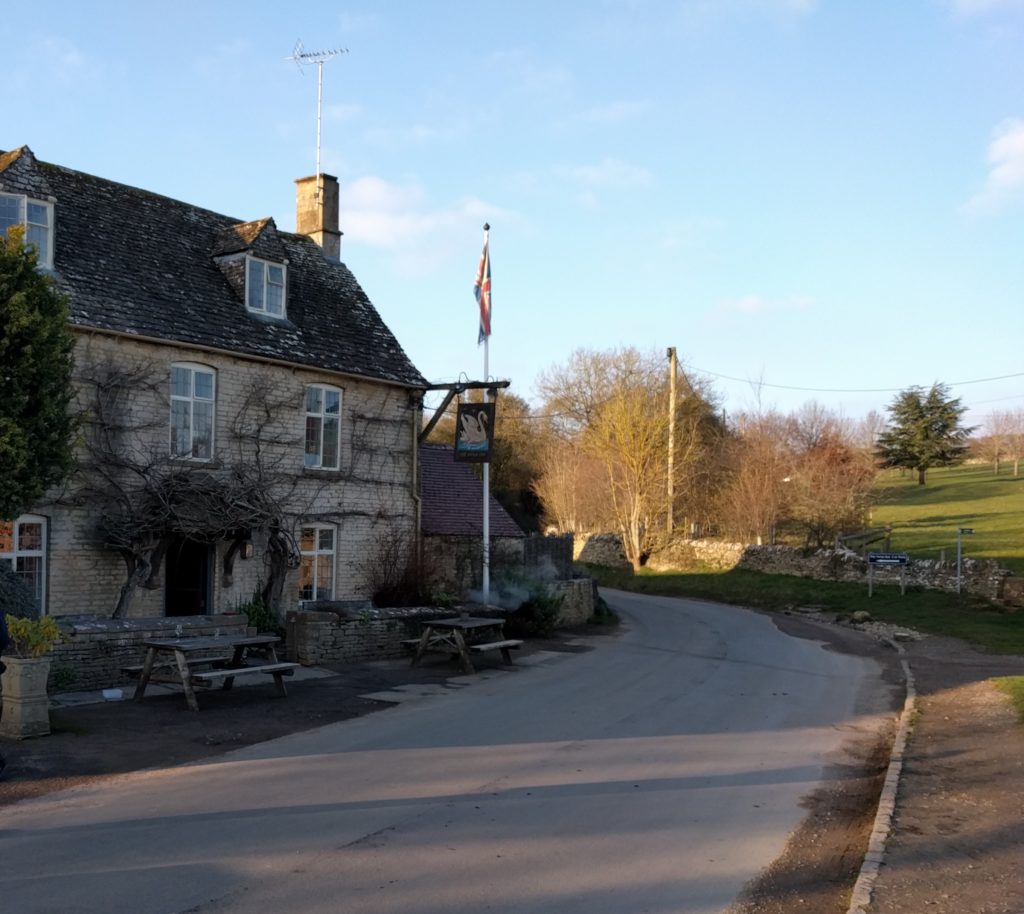Last week I joined some friends for lunch in Swinbrook, a pretty Oxfordshire village. If you are looking for a quintessential English village, then Swinbrook fits the bill. A babbling stream runs through the centre, and there are quaint honeystone coloured Cotswold cottages galore.

At this time of year, the village verges are covered in snowdrops, the first green shoots of daffodils are showing, and clumps of primroses bloom along the lanes. Rural England at its best. However, the iconic red telephone box near the village green no longer houses a telephone, but a defibrillator, demonstrating that, although Swinbrook seems set in the past, it is very much part of the 21st century.

Another jolly good reason to visit Swinbrook is the charming inn, The Swan. Situated near the bridge that crosses the River Windrush, it was once owned by the late Deborah, Duchess of Devonshire, one of the Mitford sisters. Photographs and drawings of the Mitford family decorate the public rooms, emphasizing the strong connection between this famously eccentric family and Swinbrook.

Because of its secluded location, The Swan is also rumoured to be a favourite of the many celebrities who live in the surrounding area. At least one Prime Minister is recorded as having had lunch there with a visiting foreign head of state. And if it’s good enough for the PM… well, yes, I enjoyed my lunch there too (and it was affordable even for a struggling author).

A third, and compelling reason to visit Swinbrook is the delightful church of St Mary’s. Perched on a rise overlooking the River Windrush, this tiny 12th century building, still functioning as a church today, is noted too for its connections to the Mitford family.
The Mitfords lived in nearby Swinbrook House and are remembered mostly for their unconventional and controversial lives. Head of the family, Baron Redesdale, was a noted eccentric, who famously was said to have only ever read one book*. Several of his six daughters were equally unconventional in their early years, earning attention for their wildly differing political views. Nancy was a writer, known for her sharp wit, and whose books include Love in a Cold Climate and The Pursuit of Love. Diana became notorious for embracing fascism, marrying as she did the infamous Fascist leader Oswald Mosley. Husband and wife were both interned during World War II.
Jessica was a Communist. Unity, an ardent follower and supporter of Hitler, attempted suicide when Britain and Germany declared war, succeeding only in severely wounding herself. Deborah, the youngest Mitford sister, more conventionally married into the aristocracy and eventually became chatelaine of Chatsworth House, the seat of the Dukes of Devonshire. The only daughter who did not court controversy or publicity was Pamela, who lived in rural quietude.

Nancy, Unity, and Diana are buried in the graveyard of St Mary’s, where their headstones can be seen standing in a neat row near to the main door. Their parents and Pamela are buried elsewhere in the graveyard, and inside the church there is a memorial to their brother Thomas, who was killed in action during the Burma Campaign of World War II.
Even if you have no interest in the Mitfords, the church is worth visiting for its unusual and striking features. The oldest part of the church is the north aisle, with its round pillars and pointed arches. The tower is a later addition of 1822.

The windows are mostly plain, apart from the east window of the south aisle. Remnants of stained glass are formed into one colourful window. These remnants were painstakingly rescued from the ground where they had been blasted after an enemy plane crash landed in a nearby field during WWII.
However, the most striking features of St Mary’s are in the chancel. Here can be found monuments to the Fettiplace family. The Fettiplaces were a wealthy local family who held the manor of Swinbrook in the 17th century. The monuments consist of two triple tiers of reclining figures stacked one above the other, as if on shelves, with the oldest at the bottom. The first tier dates from 1618, whilst the second, more ornate tier, was built in 1686.

Unlike any other monuments I’ve seen, these figures are posed on their sides, looking directly at the viewer. The earlier one depicts the men, heads propped on their right hands, reclining straight-legged, with the left hand placed on the hip. Different, but quite formal.

In the second and later tier the figures are set in much more informal attitudes. Here, each individual is shown leaning on their right elbow, with the left hand casually placed on a bended left knee. If they weren’t wearing armour they’d do very nicely as male underwear models. They’ve certainly got the pose right.
Nearby, I discovered the 15th century choir stalls. These stalls have beautifully carved arms and misericords. If you don’t know what a misericord is I will tell you. In the past, clergymen and choristers were forced to stand for long periods, so it was helpful for them, when their seat was tipped up for standing, that the underneath of the seat had a ledge or shelf on which they could rest. These are misericords, or pity seats, and many were intricately carved, as can be seen here. There is a man with a huge nose on one, and another shows a man with both arms outstretched. The arms of the stalls are also carved with intriguing figures, possibly depicting real people.
Sadly my visit to the church was cut short as it was time to return home, so I was unable to explore all the other features that make this tiny church so special. But despite the brevity of my visit, Swinbrook made a lasting impression and I intend to return.
Do you know of any out-of-the way places that merit a visit? Do let me know.
- White Fang by Jack London

